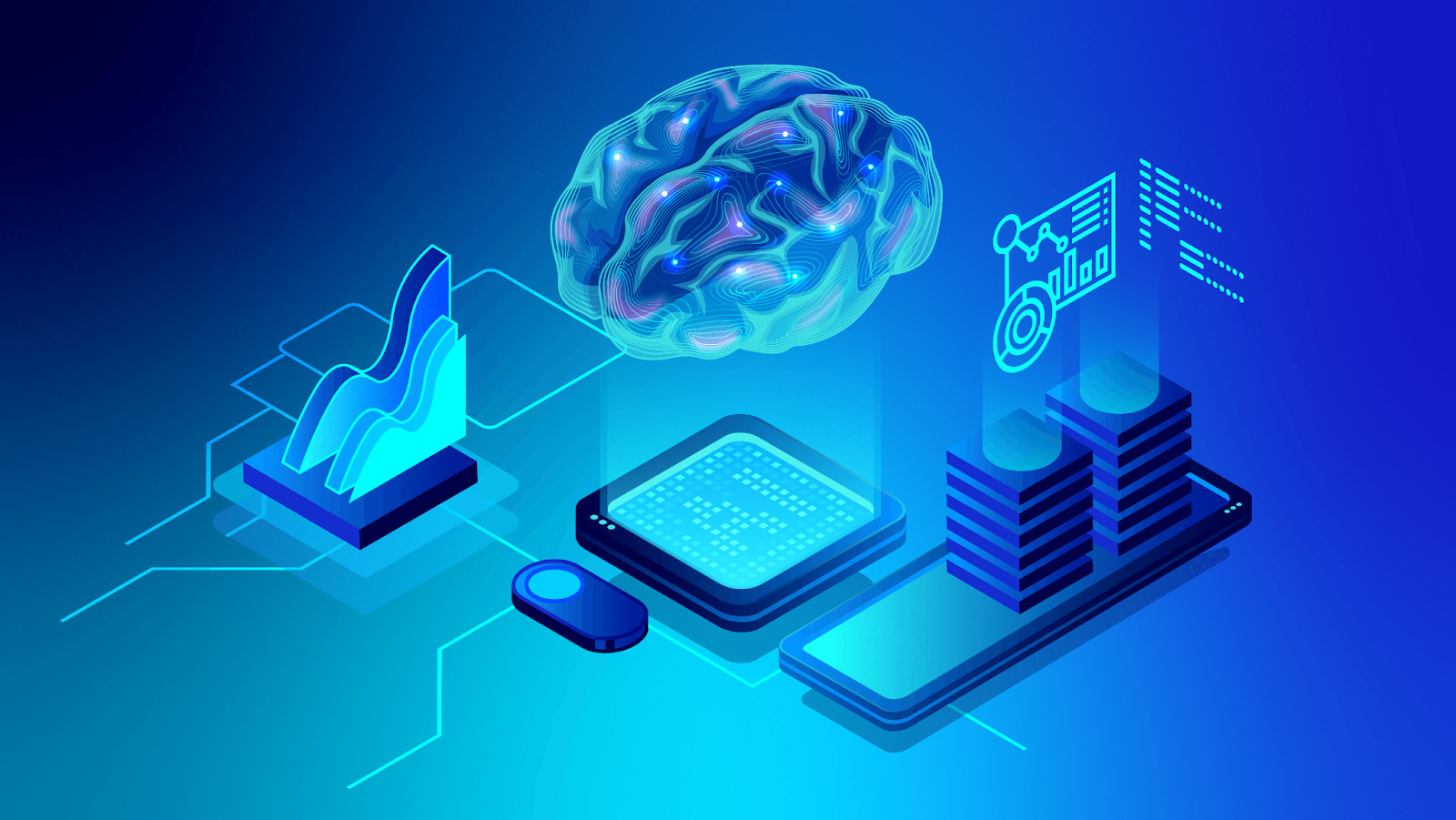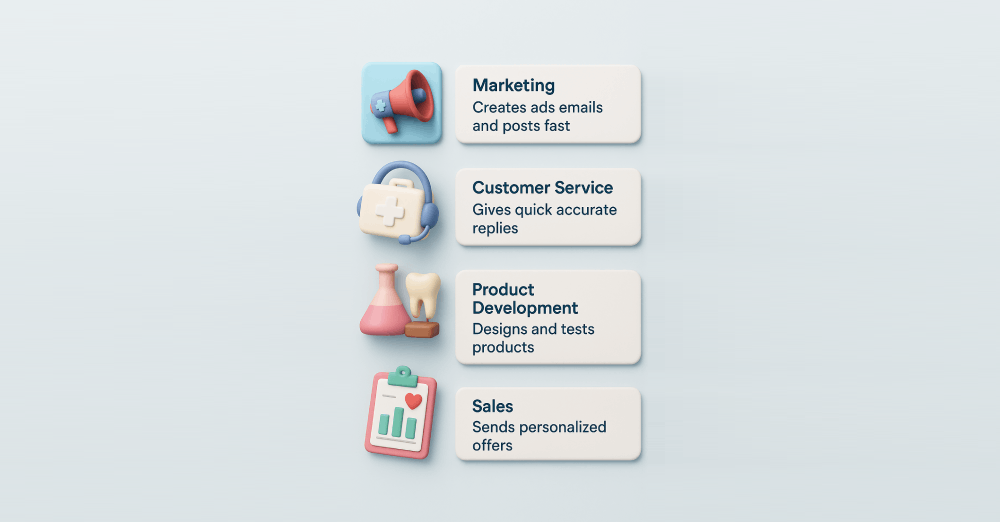Generative AI is becoming a core part of modern business. In 2025, 78 % of companies worldwide use AI in daily operations, and 71 % rely on generative AI for at least one function. The global market is projected to reach 98.1 billion USD this year. Its appeal lies in the ability to create original content, automate complex workflows, and support faster, more accurate decision-making. From marketing and sales to product design and customer service, generative AI is shifting how businesses operate. Below, we examine what generative AI is, its most valuable benefits, and how to use it effectively.

What is Generative AI?
Generative AI is a type of artificial intelligence that produces original outputs such as text, images, audio, video, or code. Unlike traditional AI, which focuses on recognizing patterns, classifying data, or making predictions based on existing information, generative AI creates something entirely new.
Its applications span many domains. In marketing, teams can generate on-brand campaign materials in seconds. In healthcare, researchers simulate novel drug molecules. In manufacturing, designers use AI to produce and test multiple prototypes without costly physical trials. These capabilities shorten development cycles and open creative possibilities that were not feasible before.
Generative AI models require large datasets and significant computing power to train. Fine-tuning with industry-specific data improves accuracy, while a human-in-the-loop approach ensures compliance, relevance, and quality. Many companies now integrate proprietary knowledge into models to keep outputs aligned with brand tone and regulatory requirements. In practice, generative AI is both a creative partner and an operational tool, merging automation with human oversight.

9 Key Benefits of Generative AI for Business
- Content Creation. Automates the production of blog posts, social updates, email campaigns, and product descriptions. In 2025, 44 % of companies use AI to generate content. Teams save time and can focus on strategy, while maintaining quality through human review.
- Personalized Customer Experiences. Generates tailored recommendations, responses, and offers based on user data. A retailer can deploy the Graphlogic Generative AI & Conversational Platform to deliver dynamic, real-time product advice that adapts to each shopper’s needs.
- Operational Efficiency. Streamlines workflows by automating repetitive tasks like data entry, report generation, and document processing. Businesses reduce errors, speed up processes, and free employees for higher-value work.
- Data Analysis and Insights. Translates complex datasets into clear, actionable summaries. 84 % of executives believe AI will enable entirely new ways of working by making data easier to use in strategic decisions.
- Innovation and Product Development. Assists in prototyping and design, producing multiple variations in minutes. Teams explore unconventional ideas and validate them faster, reducing risk in the R&D cycle.
- Cost Savings. Reduces labor costs through automation and minimizes errors. Some CFOs forecast up to 20 % gains in efficiency or revenue. Scheduling compute-heavy tasks during off-peak hours can lower energy bills.
- Scalability. Adapts to growing workloads without proportional increases in staffing. The sector has over 16 520 companies and thousands of startups offering modular, scalable AI infrastructure.
- Improved Decision-Making. Provides real-time simulations, predictions, and scenario planning. Embedding AI-generated recommendations into management workflows increases agility.
- Enhanced User Experience. Creates dynamic, interactive interfaces that respond naturally to user input. Services using the Graphlogic Text-to-Speech API can offer accessible, voice-based interactions for broader audiences.
How Generative AI Enhances Customer Satisfaction
Generative AI can transform customer satisfaction by combining speed with personalization. Instead of waiting hours for a reply, customers can receive an accurate, relevant answer in seconds. AI-driven chatbots handle simple inquiries instantly, freeing human agents to focus on complex cases. Virtual assistants can remember user preferences and adapt tone or recommendations accordingly.
A Business Insider report notes that some AI agents reduce case handling time by 52 %. This speed matters most in industries like finance, where fast answers can influence buying decisions, or healthcare, where quick triage can direct patients to the right care.
Dynamic content generation further improves engagement. For example, an e-commerce site can adjust homepage layouts, product suggestions, and promotional banners in real time based on each visitor’s browsing patterns. The result is a smoother, more relevant customer journey that fosters loyalty and repeat purchases.
Real-World Applications of Generative AI in Business
- Marketing: Automates ad copywriting, email campaign generation, and social media scheduling. AI can produce dozens of targeted ad variations for A/B testing in minutes.
- Customer Service: AI-driven support systems offer instant, accurate responses, reducing wait times. Integration with live chat allows handoff to human agents when needed.
- Product Development: Generative models assist in prototyping and design. A manufacturer can test multiple configurations virtually before committing to physical builds.
- Sales: AI can generate personalized pitches based on real-time analysis of customer behavior and purchase history, increasing conversion rates.

In the legal sector, platforms like ContractPodAi use generative AI to review contracts and highlight clauses that deviate from standard terms, helping lawyers prioritize review time more effectively. These examples show that generative AI’s potential is industry-agnostic and adaptable to both front-office and back-office operations.
Challenges of Implementing Generative AI
While generative AI offers clear benefits, adoption comes with hurdles. High initial costs for infrastructure, licensing, and training can be a barrier, especially for smaller firms. Technical complexity is another challenge — integrating AI into existing systems requires expertise and careful planning.
Ethical issues are also pressing. Data privacy regulations must be observed, and bias in training data can lead to unfair outcomes. Without proper governance, there is a risk of AI generating inaccurate, misleading, or inappropriate content. Environmental concerns are growing as well, with energy use from AI contributing to higher carbon emissions.
Ongoing training and monitoring are essential to ensure relevance and accuracy. 74 % of employees now use AI at work, but less than one-third have received formal instruction. Without skilled users, even the most advanced AI can fail to deliver value.

Best Practices for Leveraging Generative AI
- Start with a pilot project that addresses a specific need and measure results before expanding.
- Ensure transparency by labeling AI-generated content and explaining how outputs are produced.
- Embed ethical safeguards to prevent misuse, such as bias testing and privacy controls.
- Train employees not only in using the tools but also in reviewing and refining outputs.
- Evaluate continuously by tracking performance metrics, user satisfaction, and compliance with regulations.
An effective strategy involves combining technical rollout with cultural change. Leadership should communicate the role of AI clearly, highlighting its support function rather than positioning it as a replacement for human workers. Periodic audits and model retraining keep outputs aligned with evolving business needs.
The Future of Generative AI in Business
In the coming years, generative AI will integrate more closely with other technologies, including IoT devices for real-time data capture and blockchain for secure, verifiable transactions. Hyper-personalization will become the norm, with AI delivering tailored experiences across channels instantly.
Healthcare could see AI-generated treatment plans based on patient records and the latest research. Finance may use AI to generate personalized investment strategies that update automatically as market conditions change. Education could adopt AI tutors capable of adapting lesson plans to each student’s progress in real time.
Regulatory oversight is increasing. The EU AI Act introduces requirements for transparency, testing, and safety for general-purpose AI models starting 2 August 2025, with potential fines of up to €35 million or 7 % of global turnover for non-compliance. Businesses that adapt early will be better positioned to use AI responsibly and competitively.
Key Points to Remember About Generative AI for Business
- Generative AI creates original content rather than analyzing existing data.
- It boosts productivity, personalization, innovation, and operational efficiency.
- Use cases span marketing, customer service, sales, product design, and legal review.
- Risks include high costs, ethical concerns, and environmental impact.
- Adoption requires training, transparency, and ongoing model refinement.
Regulation is increasing, making compliance a strategic priority.
FAQ
It enables faster content creation, personalized experiences, automation of repetitive work, improved decision-making, and cost savings.
By offering instant, context-aware responses and adapting tone and recommendations to each user.
Marketing, retail, finance, healthcare, legal services, and manufacturing.
Costs, energy use, privacy concerns, bias, and lack of employee training.
With a small, measurable pilot project and a clear review process before scaling.
The EU AI Act and emerging national laws require transparency, safety, and bias mitigation.

